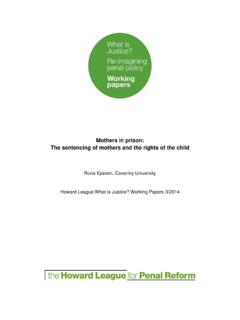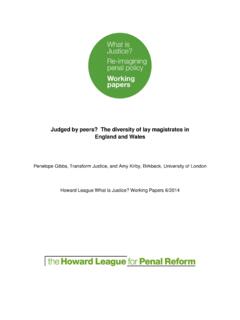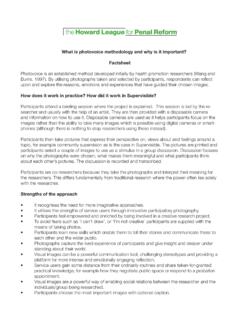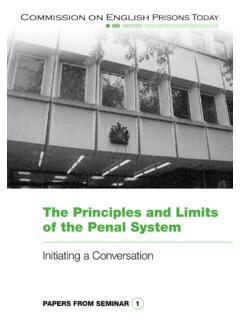Transcription of Breaking point: Understaffing and overcrowding in prisons
1 Breaking point: Understaffing and overcrowding in prisonsResearch briefing Between 2010 and 2013 the number of frontline prison officers in English and Welsh prisons dropped by 30 per cent, from 27,650 to 19,325. In some prisons the number of officers has halved in only three years and many prisons are being forced to operate with 40 per cent fewer staff than before. Since the Coalition government came into power in May 2010, 18 prisons have been closed or re-roled as immigration removal centres, two have been partially closed and three are earmarked for closure. This has resulted in the loss of almost 6,500 prison places. On 11 April 2014 the prison population stood at 85,264 255 higher than in May 2010. For substantial periods of time since 2010 the population has been significantly higher, reaching an all-time high of 88,179 in December 2011.
2 The combination of fewer prison officers, fewer cells and more prisoners has created a severely understaffed and overcrowded prison system which is now at Breaking point. Over the last year self-inflicted deaths, incidences of self-harm and assaults on prison staff have all increased. These rises are, at least in part, attributable to very low staff levels and overcrowding . prisons have also become less productive. The number of hours prisoners spend in purposeful activity has fallen and association and library visits have been cancelled due to a lack of prison officers. Urgent action is needed to ease the strain on the prison system. The Ministry of Justice must take action to reduce the prison population and increase prison officer 1. Numbers of prison officer grade staff and the prison population in each prison 2010 2014 Prison officer grade staffPrison populationSep 2010 Sep 2013 Feb 2014 Change since 2010 Askham Grange (women)2620104-8 Aylesbury (YOI)159110408-30 Bedford14311050114 Belmarsh5083608708 Blantyre House3120117-4 Brinsford (YOI)23714052877 Bristol210140599-12 Brixton21112078915 Buckley Hall1028043956 Bullingdon2631901117-4 Bure152120620371 Cardiff267200806-17 Channings Wood178130722-2 Coldingley13180501-8 Cookham Wood (YOI)1259011624 Dartmoor16310065565 Deerbolt (YOI)1781205084 Downview120800-338 Drake Hall (women)895030823 Durham311190922-52 East Sutton Park (women)2210876 Eastwood Park (women)15112033727 Everthorpe16811068414 Exeter176120543-5 Featherstone15010067728 Feltham (YOI)
3 403290621-36 Ford6040511-38 Foston Hall (women)1408030973 Frankland604450798-18 Full Sutton44432060515 Garth276180615-228 Gartree22114070023 Glen Parva (YOI)250160700-109 Understaffed and overcrowded: the state of prisons today Since the coalition government came to power in May 2010 the number of frontline prison officers in English and Welsh prisons has fallen by 30 per cent. Twenty prisons have been closed or partially closed. Over the same period the prison population has increased slightly from 85,015 to 85,469 although it has been significantly higher for periods of time in between, reaching an all-time high of 88,179 in December 2011 (Howard League, 2014). This combination of fewer prison places, fewer frontline prison officers and more prisoners has left a severely understaffed and overcrowded prison estate.
4 Already there has been a dramatic spike in the numbers of suicides in custody as well as increases in incidences of self-harm and attacks against staff. Reducing staff and prison places without taking steps to reduce the prison population is inherently risky and deeply staff reductions Figures obtained from the Ministry of Justice (MoJ) through parliamentary questions show that the number of prison officers has fallen in almost every prison since 2010, while numbers of prisoners in each prison have either risen or been static. These figures are displayed in Table 1. Grendon135100538-3 Guys Marsh13010057217 Haverigg1408063067 High Down260190116359 Highpoint3062001321377 Hindley (YOI)260180279-70 Hollesley Bay525042787 Holloway (women)22615052871 Holme House3362701212128 Huntercombe1417041151 Isis (YOI)125110614535 Kennet13670297-41 Kirkham876061533 Kirklevington Grange514029125 Lancaster216140417-107 Leeds383260122365 Leicester1389038134 Lewes206140672193 Leyhill6950485-14 Lincoln20713068318 Lindholme2401501004-87 Littlehey2711801117241 Liverpool3662401268-76 Long Lartin403300618-5 Low Newton (women)14111032065 Maidstone144100583-12 Manchester5033801158-104 Moorland3052201258494 New Hall (women)20614040951 North Sea Camp564039188 Northumberland4412701339125 Norwich21115076811 Nottingham3172201088472 Onley20410067760 Pentonville3792701342126 Portland (YOI)
5 20013057299 Preston261180702-78 Ranby2531801084-3 Risley283220109814 Rochester (YOI)23315073721 Send (women)9060274-3 Sheppey Cluster7405102813408 Stafford184120732-5 Stocken18814083924 Stoke Heath (YOI)23717063365 Styal (women)1841204426 Sudbury644058815 Swansea14811045155 Swinfen Hall (YOI)201140589-39 The Mount1581107634 Thorn Cross (YOI)1006030825 Usk/Prescoed906050174 Wakefield4252907448 Wandsworth4272701603-28 Warren Hill14211034-115 Wayland2141409992 Wealstun205150813304 Werrington8670117-10 Wetherby232180205-102 Whatton18914083825 Whitemoor4113104567 Winchester201120677-8 Wood hill45233081410 Wormwood Scrubs3102401277-21 Wymott2682001101-39 Private prisonsAltcourse3622961126-177 Ashfield146155399164 Birmingham* 4943421443-18 Bronzefield (women)185141494-33 Doncaster204184113212 Dovegate2622341100-37 Forest Bank310204144523 Lowdham Grange212216879138 Oakwoodn/a25716001600 Parc3153231313123 Peterborough (mixed)322267911-63 Rye Hill (YOI)139140623-20 Thamesiden/a 266880880 Wolds**9190365-14 prisons closed or partially closed since 2010 Prison places lostAshwell940 0 600 Blundeston1501000 500 Bullwood Hall7200220 Canterbury1060 0 300 Chelmsford214150587132 Dorchester105700 250 Shepton Mallet (and Erlestoke)18290484165 Gloucester126 00 300 Brockhill (Hewell)3302201288180 Hull308200760280 Camp Hill (Isle of Wight)
6 4732201133470 Kingston670 0 200 Lancaster Castle8300 200 Latchmere House350 0 200 Morton Hall10400400 Northallerton62500 200 Reading98700 250 Shrewsbury1130 0 300 The Verne107700600 Wellingborough14300 600 Totals276501932584682 Total places lost 6347*transferred from the prison service to G4S in October 2011 **transferred from G4S to the prison service in July 2013 Between 2010 and 2013 the total number of prison officers working in English and Welsh prisons fell by almost a third, from 27,650 in August 2010 to 19,325 in September 2013. In some prisons officer numbers have halved in the space of three years. Falls in prison officer numbers are most stark in category C prisons . In High Point prison the number of prison officers has fallen by 34 per cent since 2010 while the number of prisoners has increased by 38 per cent.
7 Brixton prison has had a 43 per cent reduction in the number of prison officers while the population has increased slightly. Wealstun prison has seen a large rise in its prison population, increasing by 59 per cent since 2010, yet numbers of prison officers have dropped by 26 per cent. Such large cuts to staffing numbers in category C prisons are particularly concerning as they will form the majority of resettlement prisons under the MoJ s Transforming Rehabilitation agenda which purportedly aims to reduce reoffending rates (MoJ, 2014a).The high-security estate has also seen large falls in numbers of prison staff. For example, in Wakefield prison there were 135 fewer prison officers in 2013 than in 2010 (a drop of 31 per cent) whereas the prison population had slightly increased. Belmarsh prison now has 30 per cent fewer prison officers than it did in 2010 but holds more prisoners.
8 Impact of prison staff reductionsSweeping cuts to prison officer numbers have had an impact on every part of prison life. Prisoners are spending more time locked up as association periods and library visits are cancelled due to inadequate staffing numbers. The number of hours prisoners spend in purposeful activity has also fallen sharply due to insufficient numbers of officers as well as teachers and workshop leaders (HM Chief Inspector of prisons for England and Wales, 2013).Deaths in custody have increased significantly. Between 2012 and 2013 self-inflicted deaths rose from 60 to 74 a 23 per cent increase (MoJ, 2014b). In the first four months of this year at least 29 people have taken their own lives in prison, a third more compared to the same period last year. Frontline staff play an important role in helping prisoners who are feeling suicidal, and can save lives by being on hand to cut prisoners down, administer first aid or request emergency medical assistance when prisoners have attempted to take their own lives.
9 Reducing officer numbers without reducing the prison population will inevitably lead to further deaths. prisons are becoming more violent places. Numbers of prisoner-on-prisoner serious assaults were 25 per cent higher in 2013 compared to 2012 and numbers of serious assaults against staff are now at the highest figure since recording practices began. In 2013, 356 members of prison staff were seriously assaulted, a 27 per cent increase since 2012 (ibid). Her Majesty s Chief Inspector of prisons , Nick Hardwick, has stated that increased rates of suicide, self-harm and violence are at least in part attributable to the large reductions in prison officer numbers (the Sunday Times, 2014).Rioting has increased dramatically. The number of times the National Tactical Response Group (also known as the prison riot squad) was called out increased by 72 per cent between 2010 and 2013 (Hansard, 2013; Hansard; 2014).
10 The Prison Officers Association has repeatedly stated that staff shortages are to blame for the increased frequency of riots, protests and other closures and overcrowding The fall in prison officer numbers must be understood in the context of a chronically overcrowded prison estate. Since the Coalition government came into power, 18 prisons have been closed or re-roled as immigration removal centres, two have been partially closed and Askham Grange, Dartmoor and East Sutton Park have been earmarked for closure. This has resulted in the loss of approximately 6,500 prison places, with a further 700 under threat. Since 2010 two private prisons have opened (Thameside and Oakwood), adding about 2,100 places. The Certified Normal Accommodation level (CNA) of the prison estate, the MoJ s own definition of a safe and decent population level, has fallen from 77,433 places in 2010 to 74,720 places in 2014 (MoJ, 2014c).







